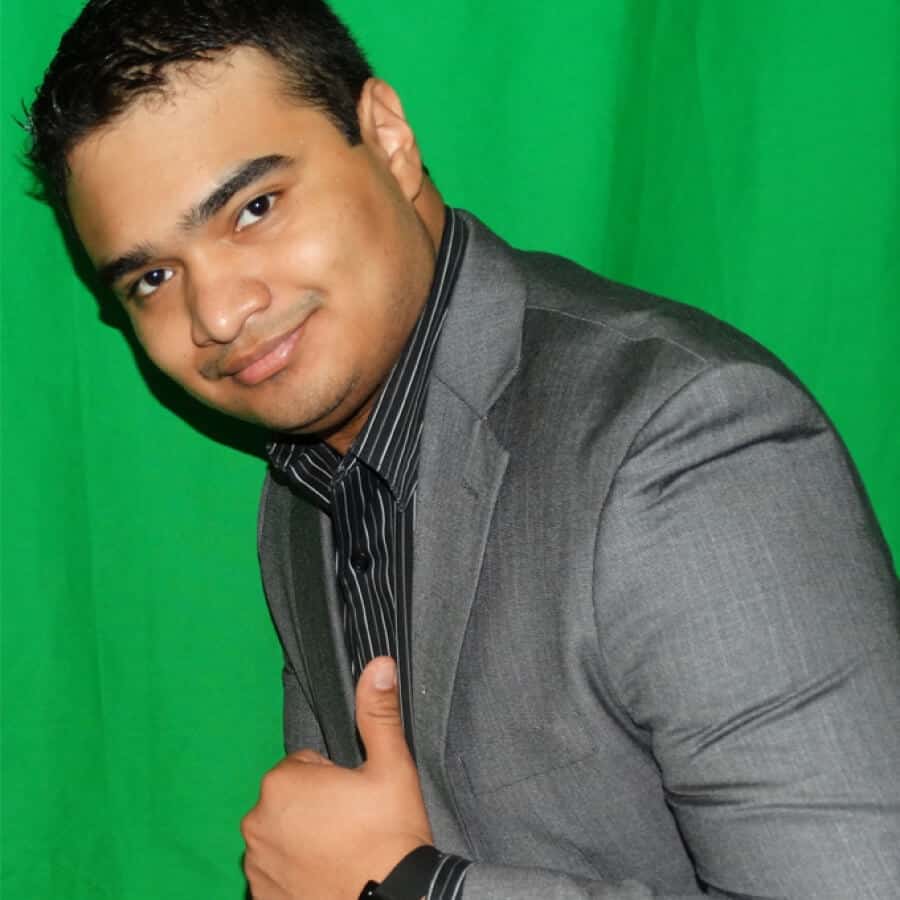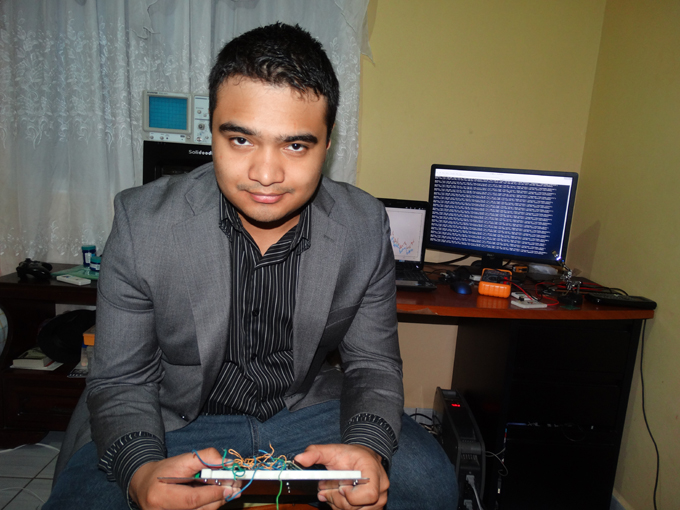Huffington Post has named him as one of the nine young tech innovators who are changing the world. After his invention called Eyeboard was presented to the public, he became internationally recognized. He started his first company at the age of 14, teaching himself software programming and digital electronics. Today, the owner of Intelsath, Luis Cruz (23), is developing new products, learning more about how to invest smartly in the future, but most of all – he spreads knowledge all around his home country, Honduras, giving inspiration to young people to learn, advance, and succeed.
Luis, long before being named one of the 25 most influential young people in the world by Youth Service America, you started your career by teaching yourself software programming and digital electronics. How is it possible to learn about such a complicated kind of science on your own?
I guess it was a combination of curiosity about science and my passion for video games. When I was a little kid, I remember that people frequently asked me what I wanted to be when I grew up. My answer was always: “A scientist!” Perhaps this was the product of watching cartoons like “Dexter’s laboratory”, but I was always fascinated by science and technology and constantly trying to see how things worked (whether I was destroying my mom’s cassettes or wondering how cartoons and video games were made). My father (an electrical engineer) used to work as a software programmer some years ago. I still remember when he got us an i486 computer with a 1GB hard drive and Windows 95 loaded. I began as a little kid to explore the endless possibilities when owning a computer. After a little while I discovered video games; I noticed I could change images on a screen, just like a movie but I was able to control them! This was fascinating to me at the age of 4-5. About a year later, my dad got me a Nintendo 64 with a game, Mario 64. The Nintendo 64 was a huge upgrade. The 3D graphics, and the ability to move through a 3D world. This is where my curiosity on how video games were made sparked, along with my interest in computer science. At the age of 13 I began to surf the Internet more frequently. I used to visit the official Nintendo of America (Nsider) online forums almost everyday. There I met a lot of people online who shared my interest in gaming and computer science. A year later, I heard that some members of those forums were developing custom video games. I then decided to start teaching myself programming languages as I was determined to design my own virtual world and program the physics into the game. After developing my own video games, I knew that was only the start. I did not want to stop there, so I started to teach myself electronics in order to build my own video game console from scratch (I was 16). I decided not to wait until college before I could start programming and developing my own software. So I used to buy programming books and read them during lunch time at school. My dreams were always centered in the idea of doing the things that I loved, which made it easy for me actually to accomplish most of my goals.
Your Eyeboard invention gave you international recognition. What it actually does is make it possible for blind people to communicate by moving their eyes. Can you briefly explain the whole mechanism to us?
The EyeBoard uses electrooculography (EOG) to detect eye positioning so that a person can navigate a keyboard. The EyeBoard consists of placing electrodes on someone’s face to “sense” the electricity passing through the skin coming from the eyeball (the eyeball has a small electric potential that can be measured with silver chloride electrodes. The person can blink twice in succession to select the letter on the keyboard that they wish to use. If the person is unable to blink, the system detects the letter they are currently hovering over after a given amount of time has passed.
So far, have you managed to collaborate with any organizations or corporations that could help you put the eyeboard in wider use, or make it more accessible to disabled people all around the globe?
There have been monetary issues. Unfortunately getting the necessary funds to deliver this technology to the the people who need it has been difficult, almost impossible (even with crowdfunding). There aren’t that many investors willing to put money into projects that are usually not considered “profitable”. The best I could do is release the code as open source and publish a DIY guide on how to assemble it.
How did you manage to develop the whole eye-tracking software with only 300 dollars?
The whole idea of the project was to reduce the cost to build a project like this. Existing technologies on the market were extremely expensive ($10,000 – $20,000), so I knew a lot of people could not afford such systems, specially in the developing world. I figured that these systems were expensive because of market conditions (supply and demand) and not because of the technology itself. A lot of people with disabilities need a system like this, but there aren’t many options out there, hence there is a huge demand for this technology but almost no companies supplying it. So by using everything I had learned in electronics in the last few years, I decided to work on the eyeboard. I grabbed my oscilloscope, my multi-meter, a handful of resistors, capacitors, op-amps, my computer, and a few microcontrollers. I used inexpensive technology to create something really useful, and that’s how the eyeboard was born.
You opened your own tech company at the age of 14, who helped you to make it possible?
I’d say my parents. They have always supported every endeavor I have worked on, whether it is something academic or entrepreneurial.
You present yourself more as an entrepreneur than as an inventor. What is more crucial for success – a good idea or a good business mind (plan)?
I’d say both, but more than an invention you need to be good at executing a plan – how are you going to deliver your invention to the world? I also believe that an entrepreneur is usually someone who is always looking for solutions to several problems. So in order to come up with a good idea, you have to see a problem first. Entrepreneurs are risk-takers, and they look for unexplored markets, that’s where innovation begins.
Today, you own the company named Intelsath. Who is on your team, and can you share some updates with us about your latest projects?
I am currently working on different ventures. Recently, I have been studying more about optimization, machine learning algorithms, and econometrics for financial forecasting. I am trying to find smart ways to invest money so that I can eventually reinvest some of that money in my projects, such as the Eyeboard. Basically if I couldn’t find investors willing to invest money for projects that could help thousands of people, I would want to be able to use my own money for that purpose. I have also teamed up with a friend of mine, Brendan Dempsey, who studied neuroscience at the same school I go to. We are working on ways to improve the Eyeboard. The next technological step in the project that we have in mind involves the development of new electrodes that do not require direct skin contact and communicate wirelessly. Another technological advancement we are currently working on includes an advanced software-based statistical searching algorithm to eliminate potential false positives. We would also like to incorporate an auto-complete feature similar to those found on any smart phone texting application.
You come from Honduras, what are the main issues of young people there?
A lot of poverty, corruption, and a lack of opportunities have limited a lot of the youth in Honduras. It’s not just poverty, or corruption, but a lack of desire to change things. It’s a vicious cycle though, if people don’t change their attitude they won’t change the country, but if the country isn’t helping (due to corruption and poverty) only a few people will have the energy left to change the country or society as a whole. As someone who has studied in the US, I always come back to Honduras and talk a lot to young people. I think that coming back to my native country to talk to young kids about technology and innovation serves as an important part of my responsibility as an entrepreneur and developer. After talking to them, it’s really rewarding to hear some of these kids tell me that I’ve encouraged them somehow to start their own tech projects or to pursue an engineering career. For instance, when I developed the video game system in high school, I was sure that although this was not a revolutionary technology, it was somehow something meaningful as a way to “show to the world” that there’s still innovation coming from developing countries. This is also how I try to honor my home country, and I hope to promote this type of behaviour among the young people. This will, hopefully, make them believe that they can change the world.
What motto do you use as a personal and business driver?
Bill Gates said he would always ‘hire a lazy person to do a difficult job’ at Microsoft ‘because a lazy person will find an easy way to do it’. I believe this to be true, simplicity is the key to success. Find ways to make your life and job easier. Although I used to work extra hard when it comes to my projects, lately I have learned that in order to meet a deadline and finish something that will lead to something big, sometimes it’s important to look for shortcuts and maximize your productivity. I actually did everything from scratch to create the Eyeboard and I think that was a huge mistake because it limited the project. Maximizing productivity is the key to a successful result.
Support us!
All your donations will be used to pay the magazine’s journalists and to support the ongoing costs of maintaining the site.
Share this post
Interested in co-operating with us?
We are open to co-operation from writers and businesses alike. You can reach us on our email at [email protected]/[email protected] and we will get back to you as quick as we can.











